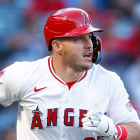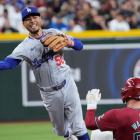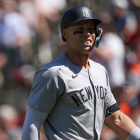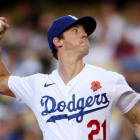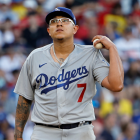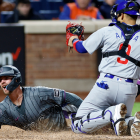The Oakland Athletics were the 2018 season's biggest team-level surprise. Despite a rotation composed of seemingly over-the-hill veterans, the A's won 97 games en route to appearing in the AL Wild Card Game.
Following a mostly quiet winter, it's worth wondering: can the A's find the same old magic?
- 2018 record: 97-65 (plus-139 run differential)
- 2019 depth chart: Click here
- 2019 schedule: Click here
Probable lineup
- Robbie Grossman, LF
- Matt Chapman, 3B
- Matt Olson, 1B
- Khris Davis, DH
- Stephen Piscotty, RF
- Jurickson Profar, 2B
- Marcus Semien, SS
- Nick Hundley, C
- Ramon Laureano, CF
Bench: Josh Phegley, C; Mark Canha, 1B/OF; Chad Pinder, UTL
For the most part, the Athletics will run back the same lineup they had last season, when they had one of the better park-adjusted offenses in baseball.
Davis is entering his walk year, but has made a habit out of homering 40-plus times (three consecutive seasons) and hitting .247 (four years in a row). Chapman is a sleeper MVP pick due to his all-world defense and above-average stick. Olson is easy to overlook but another threat to hit 30-plus homers. Laureano was one of the biggest surprise stories of last season: a high-grade center fielder with pop; the question is whether his swing-and-miss tendencies will limit him to a Drew Stubbs-like future.
The A's did make a few additions during the winter: Profar is far removed from his top prospect status, yet he showed last season he can still produce; Hundley is ideally a backup, though he could still outperform Jonathan Lucroy's 2018; and Grossman is an on-base machine who will elicit countless "Moneyball" references. Expect infielder Franklin Barreto, outfielder Nick Martini, and catcher Sean Murphy to figure into the plans at some point.
Probable rotation
- Mike Fiers, RHP
- Marco Estrada, RHP
- Brett Anderson, LHP
- Frankie Montas, RHP
- Aaron Brooks, RHP
Last year, the A's were able to succeed in spite of a rotation that looked substandard on paper. They'll have to do that again this season. Fiers and Estrada are both prone to the long ball, a flaw that should be covered (to some extent) by Oakland's cavernous stadium. Add in Anderson, who hasn't thrown more than 100 big-league innings in a season since 2015, and the top-three in the A's rotation feels befitting for a non-contender.
This group needs prospect Jesus Luzardo to dominate early on, whether he makes the Opening Day roster or not, because things don't get much better from there. Montas has a big arm and pitched well last season, but it's fair to wonder if he'll miss enough bats (and throw enough quality strikes) to be more than a back-end type. Brooks is out of options, so we're giving him the nod here. The A's could pivot and go with Luzardo or Chris Bassitt instead.
One way or the other, expect the A's to call upon their depth throughout the season: Daniel Mengden, Paul Blackburn, and Parker Bridwell included. Jharel Cotton, who is completing his recovery from Tommy John surgery, should work his way into that group, too. Meanwhile, Daniel Gossett and Sean Manaea could well miss the entire season due to their own arm woes.
Probable bullpen
Closer: Blake Treinen, RHP
Setup: Joakim Soria, RHP; Fernando Rodney, RHP
Middle: Lou Trivino, RHP; Ryan Buchter, LHP
LOOGY: Jerry Blevins
Long: Yusmeiro Petit, RHP; Liam Hendriks, RHP
The A's are expected to open the season with eight relievers. Treinen has a case for being the best closer in baseball thanks to his turbo sinker and bat-missing slider. He allowed just two homers in 80 innings last season. Rodney remains the same as ever: good stuff, shaky command. Soria is a far more reliable strike-thrower -- his 4.69 strikeout-to-walk ratio last year was the best he's ever posted in a season in which he's thrown more than 50 innings.
Save the golf jokes: Trivino emerged from obscurity to prove his cutter-fastball-heavy approach can work at the big-league level. His low-90s cutter generated a whiff on nearly 40 percent of swings. Buchter was used against a lefty nearly 60 percent of the time, so feel free to classify him as a LOOGY. The A's used Hendriks as an opener last season, and the odds are they'll do so again at some point this year. Petit has a rubber arm and has topped 90 innings in each of the past two seasons while receiving just one start.
When will Jesus come?
We touched on this in the rotation section, but the A's need top prospect Jesus Luzardo to do big things in order to have realistic playoff chances.
Luzardo appears up for the task. PECOTA projects him to be the best pitcher on the staff -- yes, better even than Treinen -- and he has the scouting reports to match, as Baseball Prospectus gave him an upside of a No. 2 starter. He sits in the mid-90s with his fastball and has a good changeup and promising breaking ball. Add in his athleticism and pitching intelligence, and he should develop into a mid-rotation starter.
Luzardo's talent isn't in question. His arrival and workload are, however. He won't turn 22 until late in the season and he's thrown more than 100 innings in a season once -- last year. Even if the A's bring him west to begin the season, he's unlikely to make a full slate of starts. That's fine -- the more Luzardo the better -- but it does cap his possible impact in 2019.
Acting on Krush
The A's are entering a pivotal season in a few senses, beginning with the fact Khris Davis will qualify for free agency afterward.
It's unclear how the market will receive Davis. He's entering his age-31 season, yet has become one of the game's top power threats. Over his three seasons with the A's, he's posted a 130 OPS+ and averaged 44 home runs a pop. At the same time, he's a negative defensively, and he'll be older than J.D. Martinez was when the latter struggled to find a free-agent home.
The A's, for their part, would appear well-positioned to sign some of their players to long-term deals. Oakland has less than $25 million committed in 2020 salaries, and somewhere around $15 million guaranteed beyond that. Locking in Davis (or Chapman, say) shouldn't feel like an impossible ask.
Except there's a hitch: the A's will soon lose their revenue sharing funds. Their percentage has steadily declined, as intended per the terms agreed upon in the collective bargaining agreement, with this season's payment representing their final one. As such, it's unclear how much Oakland's ownership will be willing to spend on payroll heading forward -- and that complicates the calculus for the front office.
It's not likely that the A's will be competing for the division crown. If they're one of two or three teams aiming for the second wild card, then there could be a scenario where they have to choose between maximizing their chances of reaching the postseason and trading Davis as a means of getting something in return.
That isn't an idyllic scenario, but it's one the A's seem more likely to face than not.
Another uphill battle
For as pessimistic as we sound about the A's -- and to be fair, it's possible Luzardo provides the rotation with the spark it needs -- let's be clear: they still have a fair chance at the playoffs.
Part of that is because the AL is a joke. There are four teams -- the Astros, Yankees, Red Sox, and Indians -- everyone expects to make the postseason. That leaves a thin middle class to compete for one spot. The A's are part of a group that includes the Rays, Twins, and Angels. Only one other AL team (the Blue Jays) is projected by PECOTA to win at least 75 games.
As it stands, PECOTA has the A's about seven games worse than the Rays (and four games worse of the Twins). Other projection systems tell a different story -- FanGraphs, for instance, considers the A's the best of the bunch -- but no matter the forecast model, it's clear that Oakland has a path to the postseason. It just isn't an easy one.
The upshot for the A's is that they've been in this situation before and done just fine. Maybe Profar and Laureano and some others play well beyond expectations. Maybe Luzardo is a star from Day 1. Maybe the A's make a bold deadline trade to land a difference-making starter. Or maybe not and the A's wind up in an even more familiar place: entering the offseason with little hope and fewer dollars than their counterparts.
Either way, the outcome will feel typical.














